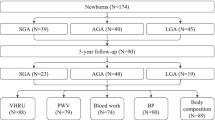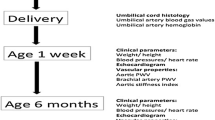Abstract
After Barker’s hypothesis, an increasing number of subsequent epidemiological studies confirmed the link among low birth weight (LBW), rapid weight gain in the first years of life, obesity in adolescent period, and increased risk of cardiovascular disease (CVD), stroke, glucose intolerance, and type II diabetes in adult life. Studies conducted in fetuses, neonates, children, and adolescents born intrauterine growth restriction (IUGR) point to the possibility that endothelial dysfunction, evaluated by aorta intima-media thickness (aIMT), carotid IMT (cIMT), carotid stiffness, central pulse wave velocity, brachial artery flow-mediated dilation, endothelium-dependent microvascular vasodilatation, echocardiographic evaluation, and arterial blood pressure, may be an inborn characteristic of subjects with LBW that persists from childhood to adult life.
IUGR is a very complex and multifactorial disorder with long-term persistence of CVD older in patients who suffered IUGR early in life. Innovative technological research in the areas of cardiovascular disease allows to deepen the study of cardiac function through wall study. The prenatal and postnatal vascular modifications showed in several human and animal studies by blood pressure and cardiac modifications in IUGR, which appear small, seem to be clinically relevant and/or a major contributor to Barker’s hypothesis association of birth weight with ischemic heart disease.
Access this chapter
Tax calculation will be finalised at checkout
Purchases are for personal use only
Similar content being viewed by others
References
Gordijn, S.J., et al.: Consensus definition of fetal growth restriction: a Delphi procedure. Ultrasound Obstet. Gynecol. 48, 333–339 (2016)
Lausman, A., Kingdom, J., Gagnon, R., Basso, M., Bos, H., Crane, J., Davies, G., Delisle, M.F., Hudon, L., Menticoglou, S., Mundle, W., Ouellet, A., Pressey, T., Pylypjuk, C., Roggensack, A., Sanderson, F., Maternal Fetal Medicine Committee: Intrauterine growth restriction: screening, diagnosis, and management. J. Obstet. Gynaecol. Can. 35, 741–757 (2013)
American College of Obstetricians and Gynecologists: ACOG Practice bulletin no. 134: fetal growth restriction. Obstet. Gynecol. 121, 1122–1133 (2013)
Barker, D.J., Osmond, C., Golding, J., Kuh, D., Wadsworth, M.E.: Growth in utero, blood pressure in childhood and adult life, and mortality from cardiovascular disease. BMJ. 298, 564–567 (1989)
Barker, D.J., Winter, P.D., Osmond, C., Margetts, B., Simmonds, S.J.: Weight in infancy and death from ischaemic heart disease. Lancet. 2, 577–580 (1989)
Mellanby, E.: Nutrition and child-bearing. Lancet. 222(5751), 1131–1137 (1933)
Harding, J.E.: The nutritional basis of the fetal origins of adult disease. Int. J. Epidemiol. 30, 15–23 (2001)
Nobili, V., Marcellini, M., Marchesini, G., Vanni, E., Manco, M., Villani, A., et al.: Intrauterine growth retardation, insulin resistance, and non-alcoholic fatty liver disease in children. Diabetes Care. 30, 2638–2640 (2007)
Barker, D.J., Eriksson, J.G., Forsen, T., Osmond, C.: Fetal origins of adult disease: strength of effects and biological basis. Int. J. Epidemiol. 31, 1235e9 (2002)
Wilmot, E., Edwardson, C., Achana, F., et al.: Sedentary time in adults and the association with diabetes, cardiovascular disease and death: systematic review and meta-analysis. Diabetologia. 55, 2895–2905 (2012)
Kavey, R.E., Allada, V., Daniels, S.R., et al.: Cardiovascular risk reduction in high-risk pediatric patients: a scientific statement from the American Heart Association Expert Panel on Population and Prevention Science; the Councils on Cardiovascular Disease in the Young, Epidemiology and Prevention, Nutrition, Physical Activity and Metabolism, High Blood Pressure Research, Cardiovascular Nursing, and the Kidney in Heart Disease; and the Interdisciplinary Working Group on Quality of Care and Outcomes Research: endorsed by the American Academy of Pediatrics. Circulation. 114, 2710–2738 (2006)
Martin, F.A., Murphy, R.P., Cummins, P.M.: Thrombomodulin and the vascular endothelium: insights into functional, regulatory, and therapeutic aspects. Am. J. Physiol. Heart Circ. Physiol. 304, H1585–H1597 (2013)
Flavahan, N.A., Vanhoutte, P.M.: Endothelial cell signaling and endothelial dysfunction. Am. J. Hypertens. 8, 28S–41S (1995)
Griendling, K.K., Fitz Gerald, G.A.: Oxidative stress and cardiovascular injury. Part I. Basic mechanisms and in vivo monitoring of ROS. Circulation. 108, 1912–1916 (2003)
Mover and Shakers in the Vascular Treed: Hemodynamic and Biomechanical Factors in Blood Vessel Pathology, Mar 11–12, 1999, in Bethesda
Nuyt, A.M.: Mechanisms underlying developmental programming of elevated blood pressure and vascular dysfunction: evidence from human studies and experimental animal models. Clin. Sci. Lond. 114, 1–17 (2008)
Langley-Evans, S.C., Phillips, G.J., Benediktsson, R., Gardner, D.S., Edwards, C.R., Jackson, A.A., Seckl, J.R.: Protein intake in pregnancy, placental glucocorticoid metabolism and the programming of hypertension in the rat. Placenta. 173, 169–172 (1996)
Berliner, J.A., Navab, M., Fogelman, A.M., et al.: Atherosclerosis: basic mechanisms. Oxidation, inflammation, and genetics. Circulation. 91, 2488–2496 (1995)
Hattersley Andrew, T., Tooke, J.E.: The fetal insulin hypothesis: an alternative explanation of the association of low birth weight with diabetes and vascular disease. Lancet. 353, 1789–1792 (1999)
McGill Jr., H.C., McMahan, C.A., Herderick, E.E., Malcom, G.T., Tracy, R.E., Strong, J.P.: Origin of atherosclerosis in childhood and adolescence. Am. J. Clin. Nutr. 72, 1307S–1315S (2000)
Lorenz, M.W., Markus, H.S., Bots, M.L., Rosvall, M., Sitzer, M.: Prediction of clinical cardiovascular events with carotid intima-media thickness: a systematic review and meta-analysis. Circulation. 115, 459–467 (2007)
Skilton, M.R., Evans, N., Griffiths, K.A., Harmer, J.A., Celermajer, D.S.: Aortic wall thickness in newborns with intrauterine growth restriction. Lancet. 365, 1484–1486 (2005)
Koklu, E., Ozturk, M.A., Gunes, T., Akcakus, M., Kurtoglu, S.: Is increased intima-media thickness associated with preatherosclerotic changes in intrauterine growth restricted newborns? Acta. Paediatr. 96, 1858 (2007)
Koklu, E., Kurtoglu, S., Akcakus, M., Yikilmaz, A., Coskun, A., Gunes, T.: Intima-media thickness of the abdominal aorta of neonates with different gestational ages. J. Clin. Ultrasound. 35, 491–497 (2007)
Hecher, K., Campbell, S., Doyle, P., et al.: Assessment of fetal compromise by Doppler ultrasound investigation of the fetal circulation. Arterial, intracardiac, and venous blood flow velocity studies. Circulation. 91, 129–138 (1995)
Cheng, J.K., et al.: Extracellular matrix and the mechanics of the large artery development. Biomech. Model. Mechanobiol. 11, 1169–1186 (2012)
Wagenseil, J.E., Mecham, R.P.: Vascular extracellular matrix and arterial mechanics. Physiol. Rev. 89, 957–989 (2009)
Bendeck, M.P., Keeley, F.W., Langille, B.L.: Perinatal accumulation of arterial wall constituents: relation to hemodynamic changes at birth. Am. J. Phys. 267, H2268–H2279 (1994)
Visentin, S., Londero, A.P., et al.: Fetal abdominal aorta: doppler and structural evaluation of endothelial function in intrauterine growth restriction and controls. Ultraschall Med. 40(1), 55–63 (2019)
Sanghavi, M., Rutherford, J.D.: Cardiovascular physiology of pregnancy. Circulation. 130(12), 1003–1008 (2014)
Liu, S., Elkayam, U., Naqvi, T.Z.: Echocardiography in pregnancy: part 1. Curr. Cardiol. Rep. 18(9), 92 (2016)
Hoit, B.D.: Strain and strain rate echocardiography and coronary artery disease. Circ. Cardiovasc. Imaging. 4(2), 179–190 (2011)
Blessberger, H., Binder, T.: Two dimensional speckle tracking echocardiography: clinical applications. Heart. 96(24), 2032–2040 (2010)
Teske, A.J., De Boeck, B.W.L., Melman, P.G., Sieswerda, G.T., Doevendans, P.A., Cramer, M.J.M.: Echocardiographic quantification of myocardial function using tissue deformation imaging, a guide to image acquisition and analysis using tissue Doppler and speckle tracking. Cardiovasc. Ultras. 5, 27 (2007)
Voigt, J.U., Pedrizzetti, G., Lysyansky, P., et al.: Definitions for a common standard for 2D speckle tracking echocardiography: consensus document of the EACVI/ASE/Industry Task Force to standardize deformation imaging. Eur. Heart J. Cardiovasc. Imaging. 16(1), 1–11 (2015)
Walker, J.J.: Pre-eclampsia. Lancet. 356, 1260–1265 (2000)
Bauer, T.W., Moore, G.W., Hutchins, G.M.: Morphologic evidence for coronary artery spasm in eclampsia. Circulation. 65(2), 255–259 (1982)
Valensise, H., Lo Presti, D., Gagliardi, G., et al.: Persistent maternal cardiac dysfunction after preeclampsia identifies patients at risk for recurrent preeclampsia. Hypertension. 67(4), 748–753 (2016)
Orabona, R., Vizzardi, E., Sciatti, E., et al.: Insights into cardio-vascular alterations after pre-eclampsia: a 2D strain echocardiographic study. Eur. J. Heart Fail. 18, 391 (2016)
Hamad, R.R., et al.: Assessment of left ventricular structure and function in preeclampsia by echocardiography and cardiovascular biomarkers. J. Hypertens. 27(11), 2257–2264 (2009)
Bamfo, J.E.A.K., et al.: Maternal cardiac function in normotensive and pre-eclamptic intrauterine growth restriction. Ultrasound Obstet. Gynecol. 32(5), 682–686 (2008)
Fayers, S., Moodley, J., Naidoo, D.P.: Cardiovascular haemodynamics in pre-eclampsia using brain natriuretic peptide and tissue Doppler studies. Cardiovasc. J. Afr. 24(4), 130–136 (2013)
Melchiorre, K., Sutherland, G.R., Baltabaeva, A., Liberati, M., Thilaganathan, B.: Maternal cardiac dysfunction and remodeling in women with preeclampsia at term. Hypertension. 57(1), 85–93 (2011)
Cong, J., Fan, T., et al.: Maternal cardiac remodeling and dysfunction in preeclampsia: a three-dimensional speckle-tracking echocardiography study. Int. J. Cardiovasc. Imaging. 31(7), 1361–1368 (2015)
Unterscheider, J., Daly, S., Geary, M.P., et al.: Optimizing the definition of intrauterine growth restriction: the multicenter prospective PORTO Study. Am. J. Obstet. Gynecol. 208(4), 290.e1–290.e6 (2013)
Vasapollo, B., Valensise, H., Novelli, G.P., et al.: Abnormal maternal cardiac function and morphology in pregnancies complicated by intrauterine fetal growth restriction. Ultrasound Obstet. Gynecol. 20(5), 452–457 (2002)
Bamfo, J.E.A.K., Kametas, N.A., Turan, O., Khaw, A., Nicolaides, K.H.: Maternal cardiac function in fetal growth restriction. BJOG Int. J. Obstet. Gynaecol. 113(7), 784–791 (2006)
Melchiorre, K., Sutherland, G.R., Liberati, M., Thilaganathan, B.: Maternal cardiovascular impairment in pregnancies complicated by severe fetal growth restriction. Hypertension. 60(2), 437–443 (2012)
Nagueh, S.F., Appleton, C.P., Gillebert, T.C., et al.: Recommendations for the evaluation of left ventricular diastolic function by echocardiography. J. Am. Soc. Echocardiogr. 22(2), 107–133 (2009)
Krause, K., Möllers, M., Hammer, K., et al.: Quantification of mechanical dyssynchrony in growth restricted fetuses and normal controls using speckle tracking echocardiography (STE). J. Perinat. Med. 45(7), 821–827 (2017)
Crispi, F., Figueras, F., Cruz-Lemini, M., et al.: Cardiovascular programming in children born small for gestational age and relationship with prenatal signs of severity. Am. J. Obstet. Gynecol. 207, 121.e1–121.e9 (2012)
Cikes, M., Sutherland, G.R., Anderson, L.J., Bijnens, B.H.: The role of echocardiographic deformation imaging in hypertrophic myopathies. Nat. Rev. Cardiol. 7, 384–396 (2010)
Barker, D.J.: The developmental origins of well-being. Philos. Trans. R. Soc. Lond. Ser. B Biol. Sci. 359, 1359–1366 (2004)
Cosmi, E., Visentin, S., Fanelli, T., Mautone, A.J., Zanardo, V.: Aortic intima media thickness in fetuses and children with intrauterine growth restriction. Obstet. Gynecol. 114, 1109–1114 (2009)
Jarvisalo, M.J., Jartti, L., Nanto-Salonen, K., et al.: Increased aortic intima-media thickness: a marker of preclinical atherosclerosis in high-risk children. Circulation. 104, 2943–2947 (2001)
Comas, M., Crispi, F., Cruz-Martinez, R., Figueras, F., Gratacos, E.: Tissue Doppler echocardiographic markers of cardiac dysfunction in small-for-gestational age fetuses. Am. J. Obstet. Gynecol. 205, 57.e1–57.e6 (2011)
Nilsson, P.M., Ostergren, P.O., Nyberg, P., Söderström, M., Allebeck, P.: Low birth weight is associated with elevated systolic blood pressure in adolescence: a prospective study of a birth cohort of 149,378 Swedish boys. J. Hypertens. 15, 1627–1631 (1997)
Author information
Authors and Affiliations
Corresponding author
Editor information
Editors and Affiliations
Rights and permissions
Copyright information
© 2021 Springer Nature Switzerland AG
About this chapter
Cite this chapter
Visentin, S., Palermo, C., Cosmi, E. (2021). Innovative Technologies for Intrauterine Monitoring of Predictive Markers of Vascular and Neurological Well-Being. In: Pani, D., Rabotti, C., Signorini, M.G., Burattini, L. (eds) Innovative Technologies and Signal Processing in Perinatal Medicine. Springer, Cham. https://doi.org/10.1007/978-3-030-54403-4_3
Download citation
DOI: https://doi.org/10.1007/978-3-030-54403-4_3
Published:
Publisher Name: Springer, Cham
Print ISBN: 978-3-030-54402-7
Online ISBN: 978-3-030-54403-4
eBook Packages: EngineeringEngineering (R0)




